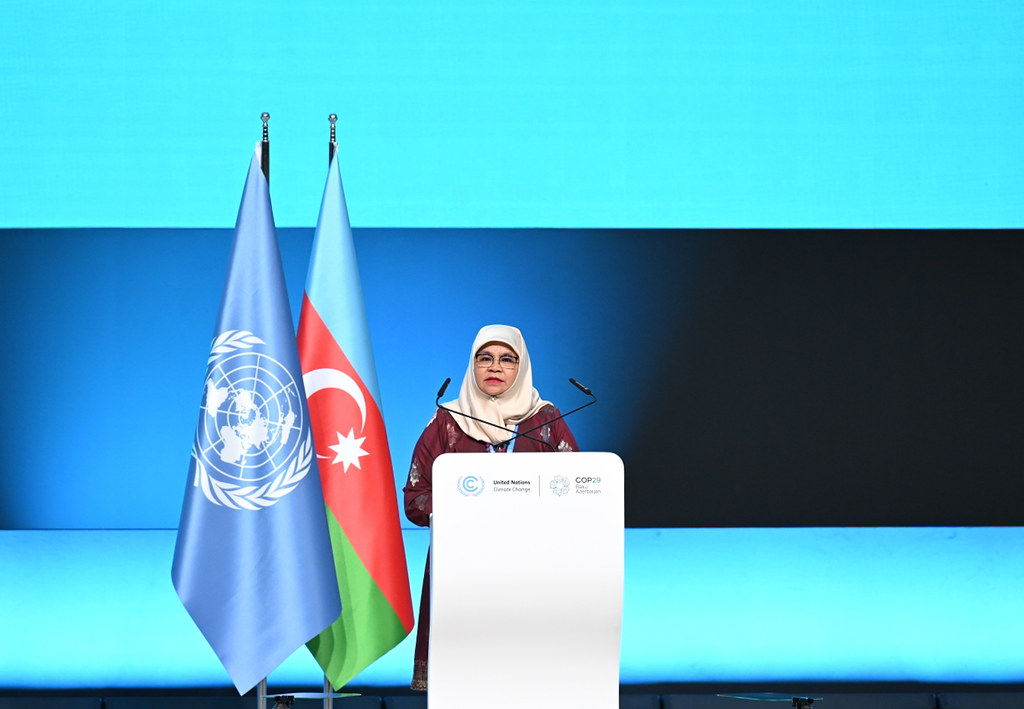RIYADH: International leaders have been urged by the UN Secretary-General to bridge the $359 billion adaptation finance gap as climate impacts intensify, threatening global stability and vulnerable communities.
During the welcoming session at COP29 Antonio Guterres expressed the urgent need to close the growing gulf in climate adaptation funding, which could reach $359 billion annually by 2030.
“You must do more to protect your people from the ravages of the climate crisis. The most vulnerable are being abandoned to climate extremes. The gap between adaptation needs and finance could reach up to $359 billion a year by 2030,” Guterres said.
He added: “These missing dollars are not abstractions on a balance sheet: they are lives taken, harvests lost, and development denied. Now more than ever, finance promises must be kept. Developed countries must race the clock to double adaptation finance to at least $40 billion a year by 2025.”
Emphasizing the need for a significant increase in concessional finance, he stressed that climate adaptation is a global investment, not charity.
The UN chief underscored the transformative potential of adaptation finance, which he argued could drive economic progress and sustainable development.
He called on wealthier nations to prioritize this support, especially for communities struggling with limited resources.
“We need countries’ new climate action plans to set out adaptation financing needs and we need every person on earth to be protected by an alert system by 2027, in line with our Early Warnings for All initiative,” Guterres said.
He also highlighted the mounting climate toll of record-breaking temperatures, intensified natural disasters, and escalating food insecurity that disproportionately impacts poorer nations.
The UN Secretary-General warned that without swift adaptation and support, millions remain at risk as communities struggle to withstand climate extremes.
Guterres reminded attendees of their commitment to keeping the global temperature rise below 1.5 degrees Celsius, calling for new national climate action plans by the next COP that cover all emissions and sectors.
He outlined that these plans must “advance global goals to triple renewables capacity, double energy efficiency, and halt deforestation by 2030.”
Additionally, he emphasized the need for a 30 percent reduction in fossil fuel production and consumption by the same date, aligning national energy strategies with sustainable development goals to attract crucial investments.
“All this must be achieved in line with the principle of common but differentiated responsibilities and respective capabilities in the light of different national circumstances. All countries must do their part,” Guterres said.
He added: “But the G20 must lead. They are the largest emitters, with the greatest capacities and responsibilities. They must bring their technological know-how together with developed countries supporting emerging economies.”
Guterres issued an urgent appeal for transformative climate finance reforms, stressing that developing countries eager to advance environmental action face daunting barriers.
“Developing countries eager to act are facing many obstacles: scant public finance, raging cost of capital, crushing climate disasters, and debt servicing that soaks up funds,” he said.
Guterres continued: “Last year, developing and emerging markets outside China received just 15 cents for every dollar invested in clean energy globally. COP29 must tear down the walls to climate finance. Developing countries must not leave Baku empty-handed. A deal is a must.”
To meet the needs of developing nations, Guterres outlined a new financial framework with five critical elements.
First, he called for “a significant increase in concessional public finance” to ease the financial pressures on developing nations.
Second, he urged for a clear pathway demonstrating how public finance would mobilize the trillions required for climate action.
“Polluters must pay,” he added, advocating for levies on shipping, aviation, and fossil fuel extraction as part of innovative financing solutions.
He further emphasized the need for a financial system that assures “greater accessibility, transparency, and accountability” to build confidence among developing nations that promised funds will materialize.
Lastly, Guterres called for a recapitalization of multilateral development banks with a reformed business model that can “leverage far more private finance” to meet the climate crisis’s demands.
The Mayor of Kuala Lumpur, Maimunah Sharif, also addressed the summit, highlighting the critical issue of plastic pollution and its far-reaching effects.
She warned that by 2040, an estimated 1.3 billion tons of plastic will contaminate the air, water, and food we consume.
“In fact, each of us now has microplastics in our bloodstream, vital organs, and, as of this year, even in babies, in pregnant women,” Sharif said.

The Mayor of Kuala Lumpur, Maimunah Sharif. Supplied.
The Kuala Lumpur mayor urged global leaders to find a resolution to foster peace and unity in addressing environmental issues.
“Let us dig deep in ourselves to find the will to give peace a chance, to make peace with nature, and to make peace with ourselves,” she said, calling for more concrete actions, timelines, and funding commitments to protect the planet for current and future generations.
She emphasized the importance of collective action, underscoring that “without collaboration and cooperation, without a whole-of-society approach, we cannot hope to survive into the next century.”
Sharif described COP29 as both a “finance COP” and an “enabling COP,” stressing the need to ensure that available funds reach those most in need.































